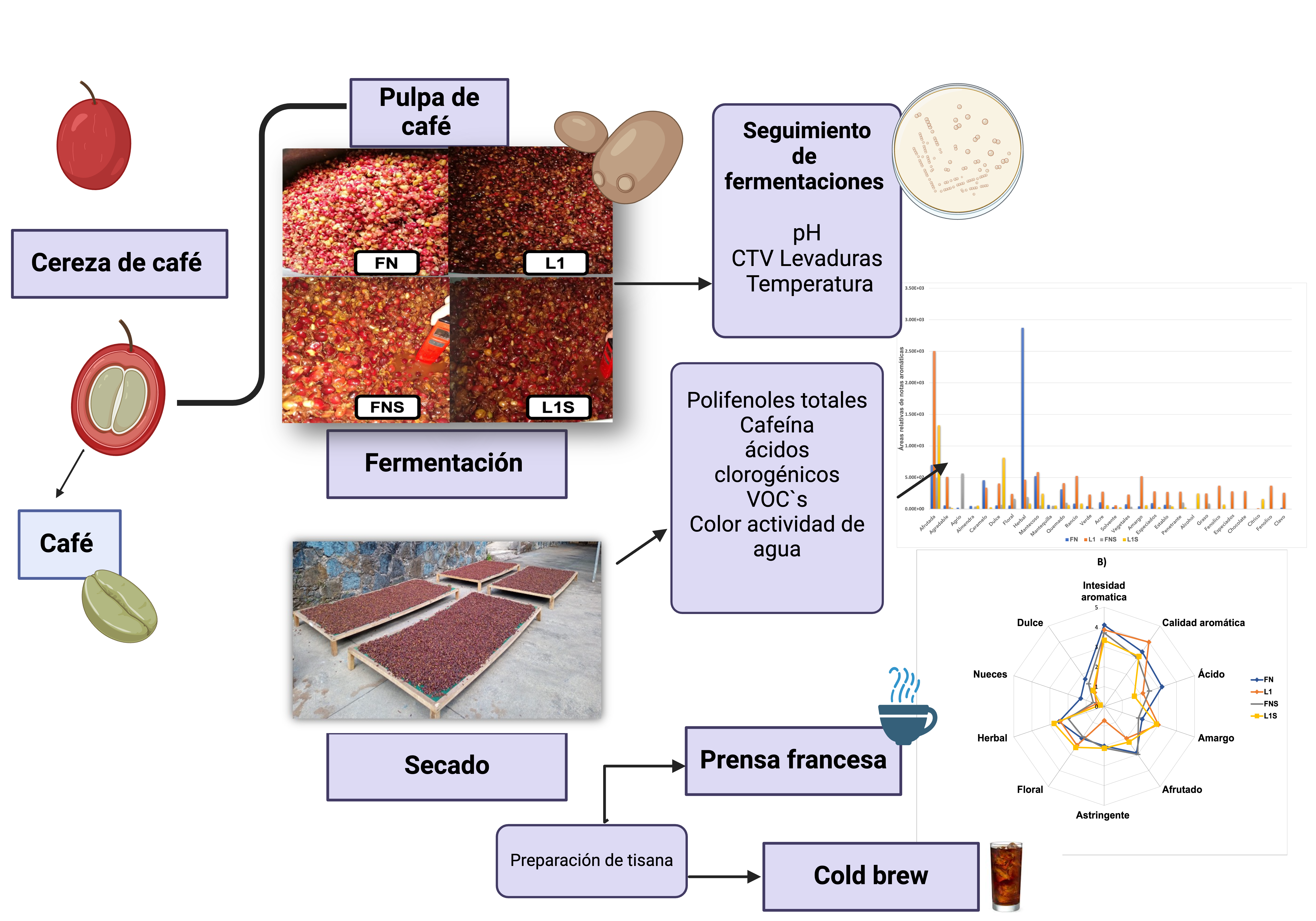Influence of the use of yeast in the fermentation of coffee pulp on its aromatic and sensory quality
DOI:
https://doi.org/10.18633/biotecnia.v27.2244Keywords:
Coffee subproducts, S. cerevisiae, volatile organic compounds, sensory evaluationAbstract
Coffee processing generates by-products, mainly coffee pulp, which represents 45 - 50 % of the weight of the fruit. There is interest in using this by-product in food formulation since it contains bioactive compounds with potential health benefits. A S. cerevisiae strain was studied to ferment coffee pulp and evaluate its impact on the volatile fraction, physicochemical composition, and sensory quality. Four treatments were studied: natural dry and submerged fermentation (FN, FNS), and fermentation with dry and submerged S. cerevisiae (L1, L1S). Volatile organic compounds (VOCs) were identified by HS-SPME-GC-FID; caffeine and chlorogenic acids were quantified by HPLC, and a sensory analysis was performed. Seventy-one VOCs distributed in 13 chemical families were identified; treatment L1 presented the highest concentration of VOCs with fruity and pleasant notes; FN was distinguished by its herbal notes. All treatments presented similar concentrations of polyphenols and chlorogenic acids. The infusion of treatment L1 presented sensory notes of hibiscus and tamarind that were corroborated by identifying linalool, geraniol, benzaldehyde, (z)-3-hexenal and ץ-undecalactone. Using a starter culture like S. cerevisiae is a promising alternative to improve the sensory quality of coffee pulp beverages and increase its commercial value.
Downloads
References
Adrianyela Noriega Salazar1, R. S. A., & Salcedo2, y M. G. de. (2008). Review : The use of coffee pulp in animal feeding Revisión Utilización de la pulpa de café en la alimentación animal. Zootecnia Trop., 26(4)(December 2008), 411–419.
Amorocho Cruz, C. M., & Muñoz Cortés, Y. (2021). Physicochemical, microbiological, and sensory characterization of fermented coffee pulp beverages. Coffee Science, 16. https://doi.org/10.25186/.v16i.1889
Angulo O., Lee Hye-Seong and O’Mahony Michael. 2007. Sensory difference tests: Overdispersion and warm-up. Food Quality and Preference 18 (2007) 190–195.
Bressani A.P.P., Martínez S.J., Sarmiento A.B.I., Borém F.M. and Schwan R.F. 2021. Influence of yeast inoculation on the quality of fermented coffee (Coffea Arabica var. Mundo Novo) processed by natural and pulped natural processes. International journal of Food Microbiology. Vol. 243: 109107. https://doi.org/10.1016/j.ijfoodmicro.2021.109107
Buck, N., Wohlt, D., Winter, A. R., & Ortner, E. (2021). Aroma-active compounds in robusta coffee pulp puree—evaluation of physicochemical and sensory properties. Molecules, 26(13). https://doi.org/10.3390/molecules26133925
Camelo-Méndez, G. A., Ragazzo-Sánchez, J. A., Jiménez-Aparicio, A. R., Vanegas-Espinoza, P. E., Paredes-López, O., & Del Villar-Martínez, A. A. (2013). Comparative Study of Anthocyanin and Volatile Compounds Content of Four Varieties of Mexican Roselle (Hibiscus sabdariffa L.) by Multivariable Analysis. Plant Foods for Human Nutrition, 68(3), 229–234. https://doi.org/10.1007/s11130-013-0360-2
Clarke, R.J. (2001). Coffee. Recent Developments, Ohio, EE. UU, Wiley-Blackwell.
Cordoba, N., Pataquiva, L., Osorio, C., Moreno, F. L. M., & Ruiz, R. Y. (2019). Effect of grinding, ex-traction time and type of coffee on the physicochemical and flavour characteristics of cold brew coffee. Scientific Reports, 9(1), 1–12. https://doi.org/10.1038/s41598-019-44886-w
Cruzalegui, R. J., Güivin, O., Fernández-Jeri, A. B., & Cruz, R. (2021). Caracterización de compuestos fenólicos y actividad antioxidante de pulpa de café (Coffea arabica L.) deshidratada de tres fincas cafeteras de la región Amazonas (Perú). Información Tecnológica, 32(5), 157–166. https://doi.org/10.4067/s0718-07642021000500157
DePaula, J., Cunha, S. C., Cruz, A., Sales, A. L., Revi, I., Fernandes, J., Ferreira, I. M. P. L. V. O., Miguel, M. A. L., & Farah, A. (2022). Volatile Fingerprinting and Sensory Profiles of Coffee Cascara Teas Produced in Latin American Countries. Foods, 11(19), 3144. https://doi.org/10.3390/foods11193144
EFSA. (2021). Technical Report on the notification of dried cherry pulp from Coffea arabica L. and Coffea canephora Pierre ex A. Froehner as a traditional food from a third country pursuant to Article 14 of Reg-ulation (EU) 2015/2283. EFSA Supporting Publications, 18(9). https://doi.org/10.2903/sp.efsa.2021.EN-6808
Esquivel, P., Viñas, M., Steingass, C. B., Gruschwitz, M., Guevara, E., Carle, R., Schweiggert, R. M., & Jiménez, V. M. (2020). Coffee (Coffea arabica L.) by-Products as a Source of Carotenoids and Phenolic Compounds—Evaluation of Varieties With Different Peel Color. Frontiers in Sustainable Food Systems, 4(October), 1–13. https://doi.org/10.3389/fsufs.2020.590597
González-Mas, M. C., Rambla, J. L., López-Gresa, M. P., Blázquez, M. A., & Granell, A. (2019). Volatile Compounds in Citrus Essential Oils: A Comprehensive Review. Frontiers in Plant Science, 10. https://doi.org/10.3389/fpls.2019.00012
Gonzalez-Rios, O., Suarez-Quiroz, M. L., Boulanger, R., Barel, M., Guyot, B., Guiraud, J. P., & Schorr-Galindo, S. (2007). Impact of “ecological” post-harvest processing on the volatile fraction of coffee beans: I. Green coffee. Journal of Food Composition and Analysis, 20(3–4), 289–296. https://doi.org/10.1016/j.jfca.2006.07.009
Guzman Rosales D. 2022. Caracterización de los derivados lipídicos oxidados en la cadena de producción de café. Tesis de Maestría en Ciencias en Ingeniería Bioquímica. Tecnológico Nacional de México/Instituto Tecnológico de Veracruz.
Heeger, A., Kosińska-Cagnazzo, A., Cantergiani, E., & Andlauer, W. (2017). Bioactives of coffee cherry pulp and its utilisation for production of Cascara beverage. Food Chemistry, 221, 969–975. https://doi.org/10.1016/j.foodchem.2016.11.067
ICO, International Coffee Organization, 2022. Producción total de los países exportadores. [pdf] Disponible en: https://www.ico.org/prices/po-production.pdf [Consultado: 08 junio 2022]
Iriondo-Dehond, A., Iriondo-Dehond, M., & Del Castillo, M. D. (2020). Applications of compounds from coffee processing by-products. Biomolecules, 10(9), 1–20. https://doi.org/10.3390/biom10091219
Ky, C-L., Louarn, J., Dussert S., Guyot B., Hamon S. and Noirot M. 2001. Caffeine, trigonelline, chlorogenic acids and sucrose diversity in wild Coffea arabica L. and C. canephora P. accessions. Food Chemistry. 75(2): 223-230. https://doi.org/10.1016/S0308-8146(01)00204-7
Geremu, M., Tola, Y.B. & Sualeh, A. Extraction and determination of total polyphenols and antioxidant capacity of red coffee (Coffea arabica L.) pulp of wet processing plants. Chem. Biol. Technol. Agric. 3, 25 (2016). https://doi.org/10.1186/s40538-016-0077-1
Lachenmeier, D. W., Schwarz, S., Rieke-Zapp, J., Cantergiani, E., Rawel, H., Martín-Cabrejas, M. A., Martuscelli, M., Gottstein, V., & Angeloni, S. (2022). Coffee by-products as sustainable novel foods: Report of the 2nd international electronic conference on foods—“future foods and food technologies for a sustainable world.” Foods, 11(1). https://doi.org/10.3390/foods11010003
Liszkowska, W., & Berlowska, J. (2021). Yeast fermentation at low temperatures: Adaptation to changing environmental conditions and formation of volatile compounds. Molecules, 26(4). https://doi.org/10.3390/molecules26041035
Londoño-Hernandez, L., Ruiz, H. A., Cristina Ramírez, T., Ascacio, J. A., Rodríguez-Herrera, R., & Aguilar, C. N. (2020). Fungal detoxification of coffee pulp by solid-state fermentation. Biocatalysis and Agricultural Biotechnology, 23, 101467. https://doi.org/10.1016/j.bcab.2019.101467
Magoni, C., Bruni, I., Guzzetti, L., Dell’Agli, M., Sangiovanni, E., Piazza, S., Regonesi, M. E., Maldini, M., Spezzano, R., Caruso, D., & Labra, M. (2018). Valorizing coffee pulp by-products as an-ti-inflammatory ingredient of food supplements acting on IL-8 release. Food Research International, 112, 129–135. https://doi.org/10.1016/j.foodres.2018.06.026
Maicas, S. (2020). The role of yeasts in fermentation processes. Microorganisms, 8(8), 1–8. https://doi.org/10.3390/microorganisms8081142
Manrique, F., & Monteblanco, A. (2015). Elaboración de caramelos blandos tipo toffe utilizando miel de café (Coffea arabica L.). 1–122. http://repositorio.undac.edu.pe/bitstream/undac/86/1/Tesis Elaboracion de caramelos blandos utilizando miel de cafe.pdf
Martinez, A. (2021). Sample Coffee brew guides. Cascara tea. https://samplecoffee.com.au/brewguides/cascara-tea
Miller, G. C., Pilkington, L. I., Barker, D., & Deed, R. C. (2022). Saturated Linear Aliphatic γ- and δ-Lactones in Wine: A Review. Journal of Agricultural and Food Chemistry, 70(49), 15325–15346. https://doi.org/10.1021/acs.jafc.2c04527
Murthy, P. S., & Madhava Naidu, M. (2012). Sustainable management of coffee industry by-products and value addition—A review. Resources, Conservation and Recycling, 66, 45–58. https://doi.org/10.1016/j.resconrec.2012.06.005
Muzaifa, M., Andini, R., Sulaiman, M. I., Abubakar, Y., Rahmi, F., & Nurzainura. (2021). Novel utilization of coffee processing by-products: Kombucha cascara originated from “Gayo-Arabica.” IOP Conference Series: Earth and Environmental Science, 644(1). https://doi.org/10.1088/1755-1315/644/1/012048
Paget, C. M., Schwartz, J. M., & Delneri, D. (2014). Environmental systems biology of cold-tolerant phenotype in Saccharomyces species adapted to grow at different temperatures. Molecular Ecology, 23(21), 5241–5257. https://doi.org/10.1111/mec.12930
Contreras-Delfín, N. 2019. Biocontrol de café verde durante su almacenamiento mediante el uso de levaduras. Disertación de M en Ciencias en Ingeniería Bioquímica. Tecnológico Nacional de México. Instituto Tecnológico de Veracruz.
Paparella, A., Shaltiel-Harpaza, L., & Ibdah, M. (2021). β-Ionone: Its Occurrence and Biological Function and Metabolic Engineering. Plants, 10(4), 754. https://doi.org/10.3390/plants10040754
Paz, J. E. W., Guyot, S., Herrera, R. R., Sánchez, G. G., Juan, C., Esquivel, C., Saucedo, G., & Aguilar, C. N. (2013). Current Alternatives for Sustainable Management of Coffee Industry. Revista Científica de La Universidad Autónoma de Coahuila, 5(10), 33–40.
Peña-Lucio, E. M., Londoño-Hernández, L., Ascacio-Valdes, J. A., Chavéz-González, M. L., Bankole, O. E., & Aguilar, C. N. (2020). Use of coffee pulp and sorghum mixtures in the production of n-demethylases by solid-state fermentation. Bioresource Technology, 305(February), 123112. https://doi.org/10.1016/j.biortech.2020.123112
Pineda- Petricholi, S. (2010). Correlación entre los análisis instrumental y sensorial para predecir el sabor y nivel de agrado en papa frita. 1–85.
Pua, A., Choo, W. X. D., Goh, R. M. V., Liu, S. Q., Cornuz, M., Ee, K. H., Sun, J., Lassabliere, B., & Yu, B. (2021). A systematic study of key odourants, non-volatile compounds, and antioxidant capacity of cascara (dried Coffea arabica pulp). Lwt, 138, 110630. https://doi.org/10.1016/j.lwt.2020.110630
Rodrigues, J., & Almeida, P. (2009). E-2-nonenal and β-Damascenone in Beer. In Beer in Health and Disease Prevention (pp. 395–402). Elsevier. https://doi.org/10.1016/B978-0-12-373891-2.00038-9
Rojas-González, A., Figueroa-Hernández, C. Y., González-Rios, O., Suárez-Quiroz, M. L., González-Amaro, R. M., Hernández-Estrada, Z. J., & Rayas-Duarte, P. (2022). Coffee Chlorogenic Acids Incorporation for Bioactivity Enhancement of Foods: A Review. Molecules, 27(11), 1–23. https://doi.org/10.3390/molecules27113400
Rosas-Sanchez, Gustavo Armando., et al. (2021). Efecto de la pulpa de café en las propiedades reológicas de masa para pan y batidos para muffins y su relación con sus parámetros de panificación.
Ruesgas-Ramón, M., Figueroa-Espinoza, M. C., Durand, E., Suárez-Quiroz, M. L., González-Ríos, O., Rocher, A. y Durand, T, 2019. Identification and quantification of phytoprostanes and phytofurans of coffee and cocoa by-and co-products. Food & function, 10(10), 6882-6891. https://doi.org/10.1039/c9fo01528k.
Ruisinger, B., & Schieberle, P. (2012). Characterization of the key aroma compounds in rape honey by means of the molecular sensory science concept. Journal of Agricultural and Food Chemistry, 60(17), 4186–4194. https://doi.org/10.1021/jf3004477
Ruta, L. L., & Farcasanu, I. C. (2021). Coffee and yeasts: From flavor to biotechnology. Fermentation, 7(1). https://doi.org/10.3390/fermentation7010009
Santos da Silveira, J., Durand, N., Lacour, S., Belleville, M. P., Perez, A., Loiseau, G., & Dornier, M. (2019). Solid-state fermentation as a sustainable method for coffee pulp treatment and production of an extract rich in chlorogenic acids. Food and Bioproducts Processing, 115, 175–184. https://doi.org/10.1016/j.fbp.2019.04.001
Sholichah, E., Desnilasari, D., Subekti, R. J., Karim, M. A., & Purwono, B. (2021). The influence of coffee cherry fermentation on the properties of Cascara arabica from Subang, West Java. IOP Conference Series: Materials Science and Engineering, 1011(1). https://doi.org/10.1088/1757-899X/1011/1/012006
Sunarharum, W. B., Yudawati, A. N., & Asih, N. E. (2021). Effect of different brewing techniques and addition of lemon peel (Citrus limon) on physico-chemical characteristics and organoleptic of cascara tea. IOP Conference Series: Earth and Environmental Science, 733(1), 012086. https://doi.org/10.1088/1755-1315/733/1/012086
Tiwari, S., Thakur, R., & Shankar, J. (2015). Role of Heat-Shock Proteins in Cellular Function and in the Biology of Fungi. Biotechnology Research International, 2015, 1–11. https://doi.org/10.1155/2015/132635
Yang, Z., Baldermann, S., & Watanabe, N. (2013). Formation of Damascenone and its Related Compounds from Carotenoids in Tea. In Tea in Health and Disease Prevention (pp. 375–386). Elsevier. https://doi.org/10.1016/B978-0-12-384937-3.00031-8
Yeager, S. E., Batali, M. E., Guinard, J. X., & Ristenpart, W. D. (2021). Acids in coffee: A review of sensory measurements and meta-analysis of chemical composition. Critical Reviews in Food Science and Nutrition, 0(0), 1–27. https://doi.org/10.1080/10408398.2021.1957767

Downloads
Published
How to Cite
Issue
Section
License
Copyright (c) 2025

This work is licensed under a Creative Commons Attribution-NonCommercial-ShareAlike 4.0 International License.
The journal Biotecnia is licensed under the Attribution-NonCommercial-ShareAlike 4.0 International (CC BY-NC-SA 4.0) license.




_(1)_(1).png)






_(2).jpg)





